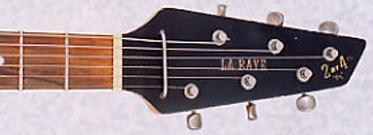
1967 LaBaye 2x4 Electric Guitar
Most guitar aficionados know the story of Les Paul’s “log”. Remember, back in the ’40s, Les figured all he needed for the perfect electric guitar was a neck attached to a chunk of wood with some pickups on it. He built his log and it worked. But his audiences were disturbed by its look, so he cut up an Epiphone archtop and attached the sides to his log, satisfying his fans. Whether or not a guitar teacher in Green Bay, WI, named Dave Helland knew about Les’ log, he too arrived at a similar conclusion. “Heck”, thought Dave, “You could put a neck on a 2-by-4 and have a guitar.” And when one day he met up with the folks from the Holman-Woodell guitar factory in Neodesha, KS, that’s just what he did. The La Baye 2×4 Six, Four and Twelve were born. La Baye because, if you know your geography, his hometown sits on a – well, look at a map!

1967 LaBaye 2x4 Electric Guitar
Holman-Woodell is probably best known as the factory that made the famous, short-lived Wurlitzer guitar line in 1966. The company was founded in 1965 by Howard E. Holman and Victor A. Woodell. Holman had worked for Wurlitzer and his company had been established essentially to make guitars for Wurlitzer. Their guitars were designed by Doyle Reading, who would later go on to do Kustom guitars for Bud Ross. Unfortunately, they didn’t quite get the painting quite right, and Wurlitzer started getting lots of returns from dealers because the paint was flaking off. By the end of the year Wurlitzer had cut Holman-Woodell loose and they tried to make it on their own with the Holman brand.

1967 LaBaye 2x4 Electric Guitar
Which brings us back to Helland and his La Baye 2x4s. Helland didn’t recall how he came in touch with Holman-Woodell, but he did and they agreed to make him a run of guitars and basses in early 1967. Working out the design wasn’t exactly a chore! Basically La Baye’s were regulation Holmans except for the 2×4 body. The neck, pickups, and vibrato are the same as found on both Wurlitzers and Holmans. The pickups are weird single-coils that, instead of using height adjustment screws to compensate for the front and back positions, use thin wafers of plastic stacked around the poles. My favorite feature, however, is the threeway switch which some Einstein decided to put on the bottom of the guitar. There’s no way, baby, you can play these without bumping that toggle. At least you’re constantly surprised at the sound you get!

1967 LaBaye 2x4 Electric Guitar
Tommy James and the Shondells played La Bayes briefly, as did a Milwaukee band called the Robbs, but that’s about as far as they got. Holman built about 45 La Bayes, mostly Sixes, but also several 12-strings, short-scale basses, and one long-scale bass, which Helland took to the 1967 NAMM show. He got no orders. Helland gave up guitar designing and guitar teaching, switched to photography. Holman didn’t last much longer. They sold out and became Alray (for Al and Ray). Reportedly a few La Baye bodies were assembled as Alrays, but by November of ’67 the doors closed for good on these Wisconsin-Kansas logs.

It wasn’t Dave Helland, but Dan Helland.
I own one of these. how much are they worth?
If you want a modern spiritual successor, try the Ministar line.
DOn’t forget…BOb1 from devo played one’a these!
Bob 1 of Devo owns one of these guitars! it used to be his primary guitar for a long time, and it’s been nicknamed “The Workhorse” and “The ‘Mr. DNA’ Guitar” by him.
Inventor Dan Hellend is alive and well in Nashville, TN, now retired from photograpy. His daughter and son-in-law, whi livein California, found and bought the one long-neck bass.
Is there anywhere I could pick blue prints for this or something like it. I’m building my own 2 x 4 bass and I need something to guide me. I’m not making a carbon copy of this bass.
Too bad there werent more…I still love mine!
P.S I need a labaye case